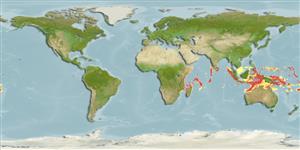>
Myctophiformes (Lanternfishes) >
Myctophidae (Lanternfishes) > Diaphinae
Etymology: Diaphus: Greek, dis, dia = through + Greek, physa, phyo = to beget, to have as offspring (Ref. 45335); diademophilus: From the combination of the names diadematus and termophilus, alluding to the close relationship of the three species and also from the fact that in several characters diademophilus is intermediate between the other two species..
Environment: milieu / climate zone / depth range / distribution range
Écologie
marin benthopélagique; profondeur 0 - 1808 m (Ref. 44036). Deep-water; 10°N - 20°S
Indo-West Pacific: common in the tropical Indian Ocean and Southeast Asian seas. South China Sea (Ref.74511).
Length at first maturity / Taille / Poids / Âge
Maturity: Lm 4.0, range 4 - 4.2 cm
Max length : 4.9 cm SL (female)
Rayons mous dorsaux (Total) : 14 - 15; Rayons mous anaux: 14 - 16. Vertically elongate Vn.
Minimum depth from Ref. 58018.
Life cycle and mating behavior
Maturities | Reproduction | Spawnings | Egg(s) | Fecundities | Larves
Nafpaktitis, B.G., 1978. Systematics and distribution of lanternfishes of the genera Lobianchia and Diaphus (Myctophidae) in the Indian Ocean. Nat. Hist. Mus. Los Angeles County, Sci. Bull. 30:1-92. (Ref. 11639)
Statut dans la liste rouge de l'IUCN (Ref. 130435)
Menace pour l'homme
Harmless
Utilisations par l'homme
Outils
Articles particuliers
Télécharger en XML
Sources Internet
Estimates based on models
Preferred temperature (Ref.
123201): 6.1 - 13, mean 8.8 °C (based on 310 cells).
Phylogenetic diversity index (Ref.
82804): PD
50 = 0.5000 [Uniqueness, from 0.5 = low to 2.0 = high].
Bayesian length-weight: a=0.01148 (0.00367 - 0.03596), b=2.99 (2.74 - 3.24), in cm total length, based on LWR estimates for this (Sub)family-body shape (Ref.
93245).
Niveau trophique (Ref.
69278): 3.1 ±0.3 se; based on size and trophs of closest relatives
Résilience (Ref.
120179): Haut, temps minimum de doublement de population inférieur à 15 mois (Preliminary K or Fecundity.).
Fishing Vulnerability (Ref.
59153): Low vulnerability (10 of 100).
